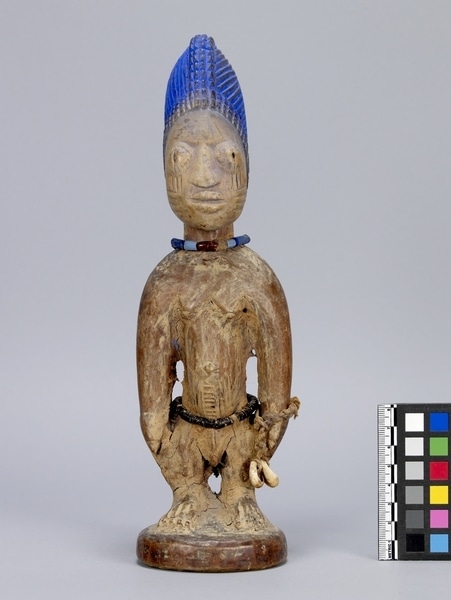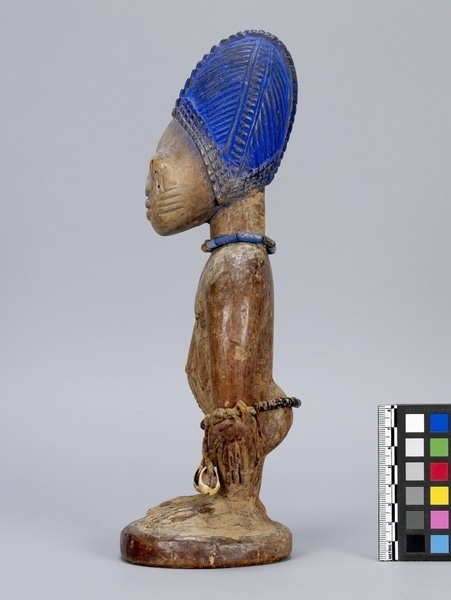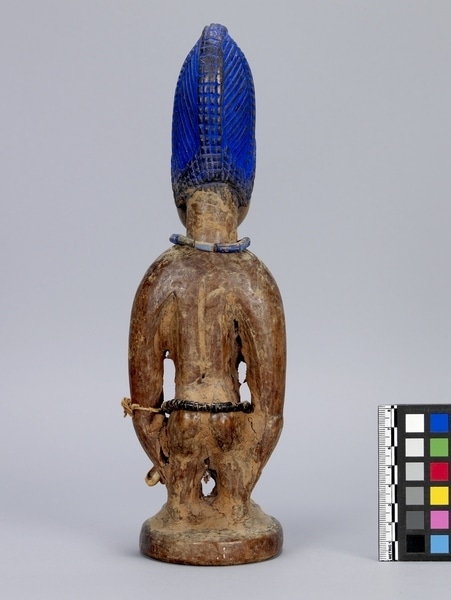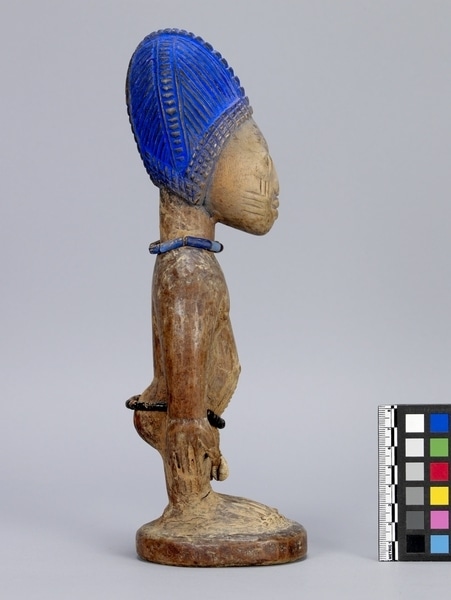Figure Item Number: K2.219 from the MOA: University of British Columbia




Description
Standing wood figure (ibeji). Head is capped with a bright blue pigment on the conical headdress. Cap is decorated with diagonal ridges. Seven tribal scarification marks on the cheeks, four of which are horizontal while the other three are vertically above the horizontal. Extended arms have hands touching thighs. Has very short legs in relation to body and the feet are large. Stands on circular pedestal. Beads around neck and hips. Covered with red camwood paste.
History Of Use
Based on the sacred duality of "twoness" (èjìwàpò) found in nature, such as life/death, right/left, male/female, twins are understood as bringers of wealth and blessings to their family if they are satisfied, or misfortune if they are dissatisfied. As a result, living twins are treated with a high degree of respect and favouritism. When a twin, or both, dies the parents consult a diviner (babalawo), who communicates the desires of the deceased; small commemorative wooden figures (ère ìbejì) are carved to honour and represent them. Yorubas believe that twins share a soul, so the family was to treat the figure as they would if the twin was still physically present. As a result, the twin was fed, washed and cared for. Rather than realistic representations, ère ìbejì are idealized forms. They are often decorated with cowrie shells, beaded or metal bracelets, necklaces, and anklets, and cosmetics, such as osun (camwood powder), indigo, and efun (white chalk). By the mid-19th century, Christianity and Islam began to influence the design of ère ìbejì. Yoruba Muslims sometimes commissioned ere ibeji with carved torah, or leather packets containing quotations from the Quran, while Yoruba Christians incorporated Virgin Mary medals or crucifixes. In the mid-20th century, manufactured or plastic dolls began to replace the traditional ère ìbejì. Today, these dolls, in addition to the use of photographs, continue to sustain the ère ìbejì tradition.
Iconographic Meaning
The facial scarification on both cheeks (ila, or “lineage face mark”) indicates a specific community to which the represented deceased twin belongs.
Specific Techniques
The indigo pigment would have come from the indigo plant or with laundry blueing imported from England.
Item History
- Made in Nigeria
- Collected between 1964 and 1966
- Owned by James Woodward before September 17, 1970
- Received from Walter C. Koerner (Funding source), Leon & Thea Koerner Foundation (Funding source) and James Woodward (Seller) on September 17, 1970
What
- Name
- Figure
- Identification Number
- K2.219
- Type of Item
- figure
- Material
- indigo pigment, wood, glass, fibre, camwood pigment and shell
- Manufacturing Technique
- carved and painted
- Overall
- height 29.0 cm, width 9.0 cm, depth 9.0 cm
Who
- Culture
- Yoruba
- Previous Owner
- James Woodward
- Received from
- Walter C. Koerner (Funding source), Leon & Thea Koerner Foundation (Funding source) and James Woodward (Seller)
Where
- Holding Institution
- MOA: University of British Columbia
- Made in
- Nigeria
When
- Collection Date
- between 1964 and 1966
- Ownership Date
- before September 17, 1970
- Acquisition Date
- on September 17, 1970
Other
- Item Classes
- carvings & sculpture
- Condition
- good
- Accession Number
- 0167/0001